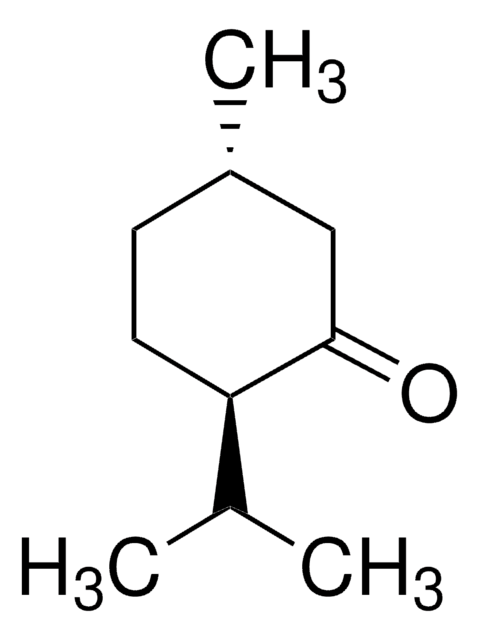63680
Menthone
mixture of isomers, ≥97.0% (GC)
Synonym(s):
2-Isopropyl-5-methylcyclohexanone
Sign Into View Organizational & Contract Pricing
All Photos(1)
About This Item
Empirical Formula (Hill Notation):
C10H18O
CAS Number:
Molecular Weight:
154.25
Beilstein:
774527
EC Number:
MDL number:
UNSPSC Code:
12352100
PubChem Substance ID:
NACRES:
NA.22
Recommended Products
Quality Level
Assay
≥97.0% (GC)
bp
85-88 °C/12 mmHg (lit.)
density
0.896 g/mL at 20 °C (lit.)
functional group
ketone
SMILES string
CC(C)C1CCC(C)CC1=O
InChI
1S/C10H18O/c1-7(2)9-5-4-8(3)6-10(9)11/h7-9H,4-6H2,1-3H3
InChI key
NFLGAXVYCFJBMK-UHFFFAOYSA-N
Looking for similar products? Visit Product Comparison Guide
General description
Menthone is a cyclic oxygenated terpene and its antioxidant potential has been evaluated. It is one of the key active component of Danshu capsule (DSC), a medicinal compound in traditional Chinese medicine.
Application
Menthone has been used in the following studies:
- To prepare the model flavor mix in a study to investigate the release of various aroma compounds in xanthan-thickened food model systems having different viscosities.
- As standard in the quantification of volatile constituents and odour-activity value (OAV) in ′Marion′ and ′Black Diamond′.
- Modified semisolid agar antifungal susceptibility method (SAAS) to investigate the anti-fungal activities of various cyclic terpenes against Fusarium verticillioides MRC 826.
Signal Word
Danger
Hazard Statements
Precautionary Statements
Hazard Classifications
Acute Tox. 4 Oral - Aquatic Chronic 3 - Eye Irrit. 2 - Resp. Sens. 1
Storage Class Code
10 - Combustible liquids
WGK
WGK 1
Flash Point(F)
156.2 °F - closed cup
Flash Point(C)
69 °C - closed cup
Personal Protective Equipment
dust mask type N95 (US), Eyeshields, Gloves
Choose from one of the most recent versions:
Already Own This Product?
Find documentation for the products that you have recently purchased in the Document Library.
Customers Also Viewed
Liza G Riachi et al.
Food chemistry, 176, 72-81 (2015-01-28)
This review discusses the relationship between the chemical composition and antioxidant property of peppermint tisane and essential oil. Phenolic acids (e.g. rosmarinic and caffeic acids), flavones (e.g. luteolin derivatives) and flavanones (e.g. eriocitrin derivatives) are possibly the major infusion antioxidants.
Du X, et al.
Food Chemistry, 119(3), 1127-1134 (2010)
J S Dambolena et al.
Toxicon : official journal of the International Society on Toxinology, 51(1), 37-44 (2007-11-27)
The minimum inhibitory concentration (MIC) of cyclic terpenes (limonene, menthol, menthone and thymol) against Fusarium verticillioides MRC 826 was assessed by using the semisolid agar antifungal susceptibility (SAAS) technique. Limonene, menthol, menthone and thymol were evaluated at final concentrations of
Egle Bylaite et al.
Journal of agricultural and food chemistry, 53(9), 3577-3583 (2005-04-28)
The influence of xanthan concentration (0, 0.02, 0.1, 0.4, and 0.8% w/w) and bulk viscosity on the release of 20 aroma compounds of different chemical classes (5 aldehydes, 4 esters, 5 ketones, 3 alcohols, and 3 terpenes) was evaluated in
Vivian Tullio et al.
Molecules (Basel, Switzerland), 24(17) (2019-09-01)
The promising antimicrobial activity of essential oils (EOs) has led researchers to use them in combination with antimicrobial drugs in order to reduce drug toxicity, side effects, and resistance to single agents. Mentha x piperita, known worldwide as "Mentha of
Our team of scientists has experience in all areas of research including Life Science, Material Science, Chemical Synthesis, Chromatography, Analytical and many others.
Contact Technical Service















